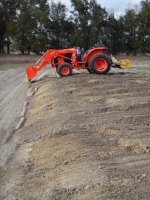The optimal way to shop for tractors is to list your tasks first, then determine bare tractor weight you need to SAFELY accomplish your tasks. Bare tractor weight is a tractor specification easily found in sales brochures and web sites, readily comparable across tractor brands and tractor models.
For most tractor applications greater chassis weight is more important than tractor horsepower. This tractor fundamental is difficult for people new to tractors to comprehend. In subcompact and compact tractor categories it requires a 50% increase in bare tractor weight before you notice a significant tractor capability increase. It takes a 100% increase in bare tractor weight to elicit MY-OH-MY!
Heavier tractors are built on larger frames with larger wheels/tires. Heavier tractors with large diameter tires have more tractive power pulling ground contact implements, pushing a loader bucket into dirt and pushing snow. Larger wheels and tires mean more ground clearance, enabling a heavier tractor to bridge holes, ruts and downed tree limbs with less bucking, yielding a less disturbing passage over rough pastures and woodlands.
Safe hillside operation demands more tractor weight than flat land operation and requires four wheel drive (4-WD). Greater mass of heavy-chassis tractors increases tractor stability when transporting loads in the FEL bucket, the most rollover prone of routine tractor tasks. Heavier tractors have adjustable rear wheel spreads; wide rear wheel spreads reduce tractor lateral instability.
Shop your weight range within tractor brands. Budget will eliminate some choices. Collect a dealer brochure for each tractor model in your weight range. I spreadsheet tractor and implement specs, often a revealing exercise. I have a column for cost per pound.
Tractors under 3,000 pounds bare weight are offered in one configuration. Most, such as the high volume kubota standard L series, are sparely equipped to hit competitive price points. Others, such as the Yanmar YT235 and Kubota
B2650/
B3350 series, include enhanced productivity and comfort components.
Most tractors under 3,000 pounds bare weight operate in residential applications on one to five fairly flat acres. These "residential tractors" fit in a typical garage.
Every tractor brand includes a model in the 2,600 pound to 3,000 pound (bare tractor) range with 100 cubic inch/24 horsepower engine ample for your tasks. Tractors under 25-horsepower are exempt from the stringent, Tier IV emission controls which abruptly increase a tractor's cost about $3,000 above the 25-horsepower demarcation.
I suggest looking at Kubota
L2501/HST/4-WD in a 2,700 pound tractor or Kubota
L3560/HST+ in a 3,500 pound, deluxe kit tractor.
VIDEOS:
Kubota Standard L Series VS. Grand L Series - YouTube
Kubota HST Plus Transmission Features - YouTube
LS makes fine tractors too but I am only knowledgable about Kubota models.


